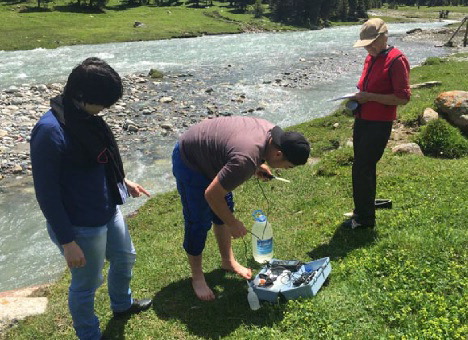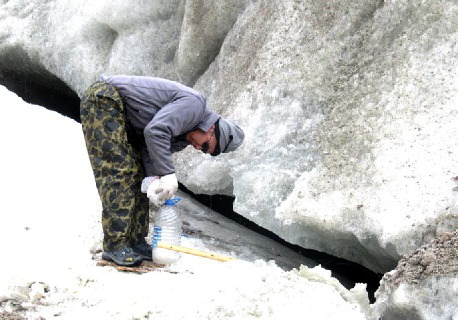|
Cycle 4 (2015 Deadline)
Water resources response on glacier dynamics in Central Asia transboundary river basins
PI: Tamara Tuzova (tv_tuzova@mail.ru), EnConsult and Institute of Water Problems and Hydro Power of the National Academy of Sciences of Kyrgyzstan
U.S. Partner: David Watkins, Michigan Technological University
Project Dates: December 2015 - May 2019
Project Overview
The water resources system in Central Asia is under stress. The water supply from seasonal snow and glacial melt is and will be impacted by climate change, and water demands will continue to increase with population growth and land use change. There are also gaps in hydrological measurements and related data following the disintegration of the USSR. This PEER project aimed to deliver important information about long-term climate and glacier-water resources changes in a major transboundary river basin of Central Asia, specifically the Amu Darya River basin and its tributaries in Tajikistan and Kyrgyzstan.
The researchers gathered data on Central Asia deglaciation during the Holocene based on the glacial moraine physical stratigraphy and isotope-chemistry analyses, seeking to understand the past and possible future scenarios of deglaciation and water resources change under global and regional climate change impacts. They compared data in this project with existing paleoclimate records from ice cores in the Altai, Tien Shan, Pamir, Kunlun, Tibet, and the Himalayas, to gain a better understanding of historical Asian climate variability. Analysis of the modern and Holocene data will help predict possible water resource changes in the future and evaluate adaptation options that respond to environment requirements, agricultural and urban demands, ecosystem services, and flood management.
Final Summary of Project Activities
Hundreds of water, melted snow, and ice samples were collected for uranium isotope analysis from the source areas of mountain river basins in the Northern Tien Shan (Chon-Kyzylsu, Kumtor, Kadjisai, Issyk-Ata, Alamedin, and Ala-Archa), Central Tien Shan (Naryn, Kara-Darya), Pamir-Alai (Kyzylsuu-Muksu-Surkhob-Obikhingou-Vakhsh, Varzob) and Pamir (Gunt-Panj). Dr. Tuzova and her colleagues used uranium isotope ratios in the samples to characterize a range of physical and chemical processes in natural aqueous ecosystems, including studying glacier contribution to the streamflow of various mountainous transboundary rivers in Kyrgyzstan and Tajikistan.
Uranium isotope ratios were also used to track the water movement dynamics and predict lake outburst floods that can be caused by melting of seasonal snowpacks or old ice. As evidenced by a number of high-altitude lakes in the Northern Tien Shan, the higher total uranium content and the greater the isotope disequilibrium in the water, the more likely that the lake will outburst. The forecasts made using this method have been verified in practice, and the PEER team recommends that the uranium isotope composition of ice and water in moraine and glacier complexes be monitored on a regular basis as a part of glacial lake outburst flood hazard assessments. The U.S. partners at the University of Colorado, Boulder also compared the uranium isotope data with water specimens of the same rivers using the ratios of other stable isotopes, and found they were compatible with the results of uranium isotope analysis.
The selected methods were field tested as part of a regional training program for geology
students of the Tajik National University and Tajik branch of the Moscow University. A total of 48 people were trained on how to collect and prepare samples for isotope analysis.
The researchers also developed a preliminary forecast of glacial (and therefore climatic) changes for Central Asia. The PEER team published more than 100 peer-reviewed papers and proceedings on their findings, including presentations at international conferences. Researchers on the project built close ties with nine nongovernmental organizations and 14 research institutes specializing in water, climate, and environmental problems, allowing them to hold a range of field and laboratory workshops, and international symposiums on innovative isotopic methods of hydrological research.
Publications
Due to the large number of papers and proceedings produced, it is not possible to include all citations on this page. However, a full list may be downloaded here. Major English-language publications are listed below:
V. Zaginaev, D. Petrakov, S. Erokhin, A. Meleshko, M. Stoffel, and J.A. Ballesteros-Cánovas. 2019. Geomorphic control on regional glacier lake outburst flood and debris flow activity over northern Tien Shan. Global and Planetary Change 176: 50-59. https://doi.org/10.1016/j.gloplacha.2019.03.003
V. Zaginaev, K. Falatkova, B. Jansky, M. Sobr, and S. Erokhin. 2019. Development of a Potentially Hazardous Pro-Glacial Lake in Aksay Valley, Kyrgyz Range, Northern Tien Shan. Hydrology 6(1): 3. https://doi.org/10.3390/hydrology6010003
I. Matveyeva, F. Meiirman, N. Nursapina, B. Satybaldiyev, T. Tuzova, Z. Shalabayev, and B. Shynybek. 2019. Concentration of uranium isotopes by in-situ coprecipitation on activated coal and iron (III) hydroxide. Chemical Bulletin of Kazakh National University, Inorganic Chemistry 92(1): 4-11. https://doi.org/10.15328/cb1000
Sergey Aleksandrovich Erokhin, Vitalii Viktorovich Zaginaev, Anna Alexandrovna Meleshko, Virginia Ruiz-Villanueva, Dmitry Aleksandrovich Petrakov, Sergey Semenovich Chernomorets, Karina Saidovna Viskhadzhieva, Olga Valerjevna Tutubalina, and Markus Stoffel. 2018. Debris flows triggered from nonstationary glacier lake outbursts: the case of the Teztor Lake complex (Northern Tian Shan, Kyrgyzstan). Landslides 15(1): 83-98. https://doi.org/10.1007/s10346-017-0862-3
R. Satylkanov. 2018. Ablation of Ice and Snow of Kara-Batkak Glacier and Its Impact on River Flow. Journal of Climate Change 4(2): 1–14. https://doi.org/10.3233/JCC-180009
Alice F. Hill, Cholpon K. Minbaeva, Alana M. Wilson, and Rysbek Satylkanov. 2017. Hydrologic Controls and Water Vulnerabilities in the Naryn River Basin, Kyrgyzstan:
A Socio-Hydro Case Study of Water Stressors in Central Asia. Water 9(5): 325. http://www.mdpi.com/2073-4441/9/5/325
V. Zaginaev, J.A. Ballesteros-Cánovas, S. Erokhin, E. Matov, E. Petrakov, and M. Stoffel. 2016. Reconstruction of glacial lake outburst floods in northern Tien Shan: Implications for hazard assessment. Geomorphology 269: 75-84. http://dx.doi.org/10.1016/j.geomorph.2016.06.028
 |  | | The team conducted a number of field visits to collect water, ice, and moraine samples (photo courtesy of Dr. Tuzova). |
Back to PEER Cycle 4 Grant Recipients
|





